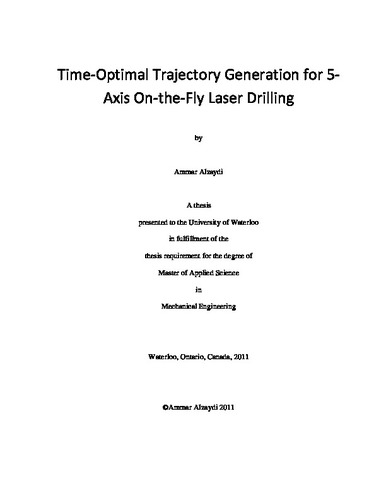| dc.description.abstract | On-the-fly laser drilling provides a highly productive method for producing hole clusters (pre-defined groups of holes to be laser drilled) on freeform surfaced parts, such as gas turbine combustion chambers. Although the process is capable of achieving high throughputs, current machine tool controllers are not equipped with appropriate trajectory functions that can take full advantage of the achievable laser drilling speeds. While the problem of contour following has received previous attention in time-optimal trajectory generation literature, on-the-fly laser drilling presents different technological requirements, needing a different kind of trajectory optimization solution, which has not been studied prior to this thesis.
The duration between consecutive hole locations, which corresponds to the laser pulsing period, has to be kept constant, ideally throughout the part program. However, the toolpath between the holes is not fixed and can be optimized to enable the shortest possible segment duration. To preserve the dynamic beam positioning accuracy and avoid inducing excessive vibrations on the laser optics, the axis velocity, acceleration, and jerk profiles need to be limited. Furthermore, to ensure that hole elongation does not violate the given part tolerances, the orthogonal component of part velocity relative to the laser beam needs to be capped. All of these requirements have been fulfilled in the trajectory optimization algorithm developed in this thesis.
The hole locations are provided as pre-programmed sequences by the Computer Aided Design/Manufacturing software (CAD/CAM). A time-optimized trajectory for each sequence is planned through a series of time-scaling and unconstrained optimization operations, which guarantees a feasible solution. The initial guess for this algorithm is obtained by minimizing the integral square of the fourth time derivative (i.e. ‘snap’). The optimized trajectories for each cluster are then joined together or looped onto themselves (for repeated laser shots) using a time-optimized looping/stitching (optimized/smooth toolpath to repeat/loop a cluster or connect/stitch between consecutive clusters) algorithm. This algorithm also minimizes the integral square of jerk in the faster axes. The effectiveness of the overall solution has been demonstrated in simulations and preliminary experimental results for on-the-fly laser drilling of a hole pattern for a gas turbine combustion chamber panel. It is shown that the developed algorithm improves the cycle time for a single pass by at least 6% (from kinematic analysis of the motion duration), and more importantly reduces the integral square of jerk by 56%, which would enable the process speed to be pushed up further. | en |

